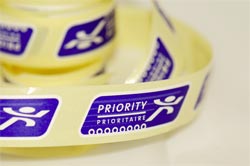It’s less than three weeks to Overloaded 2014, IORG’s June 7 conference in San Francsico. I’m going – are you? Have you registered yet?
I was discussing email overload solutions with a team of managers and we were considering how to differentiate urgent messages, when one guy asked:
What is an urgent message? And who decides it’s urgent, anyway?
Now, that is a deceptively simple question, one well worthy of some thought.
What do we mean by Urgent?

Although people seem to have a gut feeling of what “Urgent” means, once you open it for discussion you get different viewpoints.
The dictionary tells us that urgent means “compelling or requiring immediate action or attention; imperative; pressing”. In the context of email, we can agree that a message is urgent if there is importance that it be read sooner rather than later. How soon? That is usually not specified. The implication of ASAP is not always true: sometimes an hour or two will do fine. In fact, if a message needs reading in minutes it had best not go through email at all – that’s what SMS or IM is for, and one company I worked with made it an explicit norm: “Thou shalt respond to all non-urgent messages in two business days – and to all urgent messages not via email”.
It is, of course, key to distinguish Urgent from Important, a distinction whose lack accounts for a good deal of lost productivity. Urgent is about time; Important is about value. The notion of an Urgent mail is that it needs to be read fast because it has time-sensitive information or action items whose nature demands immediate attention; the importance (or lack thereof) of providing such attention is a whole different matter…
Urgent for WHO?
When a message is marked urgent, a key question is who is it urgent for. I see three possible meanings:
- Urgent for the recipient: “You will want to read this now – you’ll be happy you did”.
- Urgent for the sender: “I really want you to read this now – it will make my day”.
- Urgent for the organization: “It is important for our enterprise that you read this now”.
In a well run organization these three should coincide. Since it is the sender who designates the urgency, it requires trust – a hallmark of a good organization – for the recipient to believe the designation and act on it.
How do we mark urgency?
Most mail platforms have a way to flag urgency – more or less. Outlook, for instance, has the little red “!” icon, which people take to mean the message is urgent – whereas in fact it stands for “Important”! Since this is a widely held error, it does get used to make messages stand out – but in truth many people tend to ignore it altogether.
A better way to mark urgency is with a subject line prefix cue: start the subject with “HOT”, or “URGENT”, or “911”, or “Time Sensitive”. A number of companies whom I helped launch information overload interventions opted to standardize on one of these across the company. A variation is to use in the subject an email hashtag, #Hot.
If something is really urgent, you may resort in addition to flagging it with an alert that pops up a warning once received in the Inbox; this is done in Outlook with a follow-up flag having a Today due date.
What you can do about this
As a sender, you should safeguard your coworkers’ trust by not abusing the freedom you have to invoke urgency – if you mark too many messages URGENT you’ll end up like the boy who cried Wolf!
As a recipient, you owe it to your senders to take their Urgency flags seriously. At a minimum, when you check your mail (which you should only do in preset times of the day!), open the messages marked Urgent right away, to verify what’s going on.
You can also take advantage of the large selection of software tools and add-ons that try to identify, and separate, urgent messages for you automatically. Take a look at my Definitive Guide to Information Overload Solutions – it has an entire section titled “Automation of incoming mail classification”.
As a manager, you should try to standardize expectations across your group. You’d do well to hold a discussion in a group meeting to define what constitutes an urgent message, when it should be communicated by email (vs. phone or other channels), how urgent messages will be marked, and how soon they must be replied to. Make sure everyone is on board with the norms you define in this discussion (and that future new hires are educated about them when they join your group).
A concluding comment
Outlook has a complementary icon to the red “!”: the blue down-pointing arrow, which denotes Low Importance. This seems silly: who would mark their message as Low? Yet a few rare righteous people do, and when I get a message like that, I always make sure to read it. My thinking goes like this: “if this coworker was considerate enough of my productivity to tell me not to hurry, and yet they felt the message merited their trouble to assign it this special annotation, they must have really thought I need to read it!” – and so, I do!

